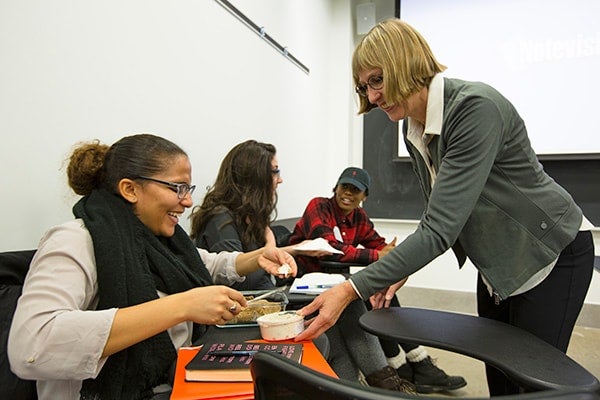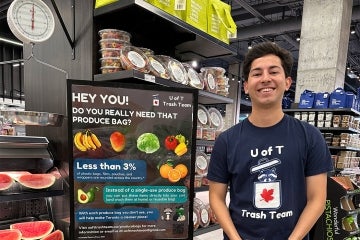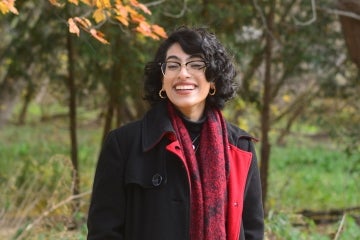
Food Matters: this New College course encourages students to snack in class
Published: February 26, 2016
Most professors aren’t too keen on students eating in class, but the University of Toronto's Lori Stahlbrand positively encourages it. In fact, every week she hands around food – sometimes treats that she’s made herself – to the students in her first-year Food Matters class.
Stahlbrand is a lecturer in the New College New One: Learning Without Borders program. She’s also the interim coordinator of the program, which includes three other courses: Travelling Words – Language and Diversity, Digital Technology in Society, and Arts and Community. The courses explore the themes of globalization and citizen engagement and build research and writing skills, Stahlbrand says. Like all of U of T’s One programs, each course has at most 25 students who meet for two to three hours each week where they present papers, listen to guest speakers and, for Stahlbrand’s lucky students, sample treats made from the foods under discussion.
Read more about the U of T One programs
“It’s the International Year of Pulses,” Stahlbrand says as she passed around a tray of gluten-free brownies made from ground-up Romano beans. “Can any of you tell us about dishes made from pulses that you grew up with?”
A couple of students from South Asia mention dhal, students from Brazil and Mexico reminisce about rice and bean dishes, and a student from the Middle East describes how hummus is made. Their classmates munch on the brownies and examine the samples of lentils and chickpeas that Stahlbrand is also handing around. Pulse, Stahlbrand tells us, comes from the Latin word puls, meaning thick soup or porridge.
Stahlbrand then switches topics. “I want to tell you about some very significant news. For the past 10 years, Aramark – one of the biggest food companies in the world, has handled food services at U of T. But the university has made the decision not to renew the contract and to take over food services itself. That means that as of September, if you’re in residence or if you go to Robarts or Sid Smith or Gerstein, the food that you will be eating will be managed and prepared by staff and chefs who work for U of T and not for an outside contractor. This has big significance because it’s the largest university to have done this as far as we know anywhere in North America.”
Read more about U of T’s decision to directly operate food services
Each class is organized around a particular issue, such as food and hunger, food and waste, genetic engineering, or the environmental impact of growing food, Stahlbrand says. In the first semester of the course, students keep a food diary, recording everything they eat or drink for one day each week. The second semester is devoted to the preparation and writing of an academic research paper, with a celebration at the end of the year, Stahlbrand says. Students also take field trips to Kensington Market or local food processors such as ChocoSol Traders or listen to guest speakers from the community.
The students come to the course for a variety of reasons, she says. “It ranges from people who just like to eat and think it sounds interesting to take a course about food, to student athletes who want to find out more about the connection between food and health, to people who have worked as bakers or volunteered on farms to people who have been food security activists since high school.”
First-year life science student Gabriella Burt-D’Agnillo, for example, hopes to major in nutritional science. Her favourite part of this course, she says, “is how it uses the central idea of ‘the food system’ to branch off into different topics for each class discussion. I particularly enjoyed watching the film King Corn, and learning about the abundance of corn and its uses in the food system today.”

Besides teaching in the New One program, Stahlbrand also has a part-time appointment as New College’s food equity coordinator. In that role, she connects faculty, students and the community through food, develops food-related programming and liaises with community groups on food issues. “My hope is that I can help students make connections between what they eat and what is happening in the world around them.”
Burt-D’Agnillo agrees. “Lori is always prepared to help her students, and she is a great resource for discussing topics that even reach outside the course material.”
Stahlbrand’s connection with food comes naturally. “Food has always been important in my life. My parents always had a garden,” she recalls. “There are stories in my family of how my aunt farmed the empty lot next to their house and grew enough food to help them get through the Depression. My own parents were among the original health food enthusiasts back in the 1950s.”
The former CBC Radio journalist has long been involved in food politics. Along with Rod MacRae, she and her husband, Wayne Roberts, co-authored the book, Real Food for Change in 1999. She’s also founder and former president of Local Food Plus and is faculty advisor to the new U of T Food Policy Council.
Food, she says, is one of the few areas in which we can affect real change.
“For a lot of people, when they hear about issues like climate change, they’re just overwhelmed, and it’s paralyzing. I think that food is one of the ways that can really give people hope and I’m very excited about working in an area that’s hopeful and positive.
“And delicious.”



